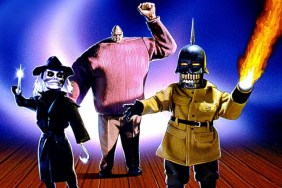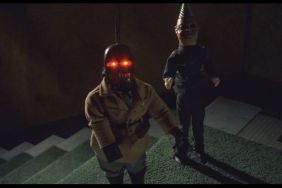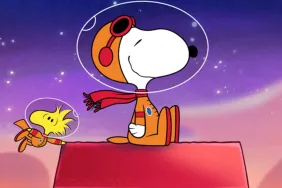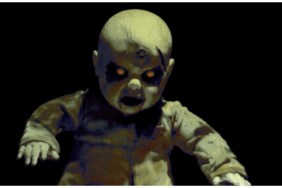“Ragnar’s really the first great Viking chieftain that comes out of the mists of myth and legend.”
It’s a cool Autumn day in a studio lot in rural Ireland, and Michael Hirst, creator of “Vikings” is talking about the series’ lead character, Ragnar Lothbrok. Hirst, whose previous credits include “The Tudors,” “The Borgias,” and the films Elizabeth and Elizabeth: The Golden Age, has a penchant for historical drama. Indeed, his entire career has been built around a knack for telling stories about the past and making them resonate with modern audiences.
With limited sources of information on the Viking period, compared to some of the other eras he’s written about, working out what actually happened is somewhat difficult, as Hirst explains, “it’s the dark ages, they never wrote anything down themselves, what was written about them was written by hostile witnesses so there’s a limit to what we know about them.” Although to some degree, this actually works in Hirst’s favour. “We don’t know huge amounts about Ragnar, but we know enough for me to thread a narrative about him.” So with such little to go on, how do you even begin to create a character? “Ragnar believed he was descended from the god Odin, who was not only the god of slain warriors, but he was the god of curiosity.” Hirst reveals, “So I thought, I’ve got this great character here, and I’ll make him as curious as Odin’ So the reason he’ll go west is, he’s not going principally for plunder, he’s not motivated by rape and plunder and all the nasty things we associate Vikings with, he’s interested in exploring other places, other lands.”
While there may be some room for leeway when it comes to the specific people and events, thanks to the archaeological evidence, we know a lot more about the world these characters lived in. “Accuracy is paramount,” explains Set Dresser, Jill Turner, “We are accurate as far as the houses and with our dressings, what I try to do is keep it pretty good.”
As a set dresser, Turner’s job is to think of logical, story-centric reasons for the items she places in a scene. In the case of Vikings, a lot of that reasoning comes directly from the archaeology, “I think the fireplace and the cold climate dictated everything. It’s the fireplace in the middle, and then you’d have generally, your benches either side. Really they all lived in one big hall, where they ate and they slept.”
Of course, like Hirst, Turner had to make some concessions to the fact that she was working on a TV show rather than a museum piece. When it came to the sets, her main concern was lighting. For the houses in the village of Kattegat this meant rows of windows, to allow light to come through, but for the main hall, in which most of the action takes place, more drastic changes were needed.
“Because the roof is pitched, and because there are no windows in there, it was a bit of a challenge. So we made these fantastic some of them are dragon heads, some of them are Norse figures we made big heads to hang woks on chains. So we had all them going along the centre aisle.”

And while these compromises help with filming, the overall effect is to create a world so real that even the actors find it convincing, as Clive Standen, who plays Rollo in the series, confesses, “You turn up to work and it’s almost like there’s no acting required. It’s all there for you. You ask for a prop and it’s there, a living, working Viking board game.”
One of the more curious elements of Viking culture to modern audiences is their belief in a number of different, living Gods. The show could have glossed over this, but instead Hirst chose to embrace it. “I wanted to show the world from a Viking point of view,” he explains, “one of the ways to show the world from their point of view was perhaps to show Odin on the battlefield. Because Vikings believed that Odin was on the battlefield. This was not fantasy to them, it was the real thing.”
It’s a fairly unusual thing to do for a series rooted in historical fact, but to Hirst it makes complete sense, “The metaphor I always use is, if I were writing about the story of Jesus Christ, and we see him in the cave after the crucifixion, and then we see him come back to life, is that fantasy? Because if it’s fantasy, then the whole Christian religion has no basis at all, so to Christians, it’s not fantasy, it’s fact. And for me, the same thing goes for seeing Odin or Mjolnir on the battlefield for the Vikings.”
And then, of course, there is that battlefield. The Vikings were a warrior race, and in spite of being a prime time show, Vikings pulls no punches in this department. There’s not yet been a single episode without at least some small measure of bloodshed, and it’s unlikely we’ll ever see one. The man who facilitates all this combat is the series’ armourer, John McKenna. “Obviously you can’t battle with aluminium and steel anymore, so this is what we have as a sword blade,” he reveals, “it’s bamboo. Made to look like metal. That’s what the stunt guys fight with, it’s what the cast fight with.”
His workshop is a remarkable place. Part museum, part toolshed, the walls are lined with axes, shields, swords and spears, each in different stages of construction. “What you do is take the raw bamboo.” He begins, taking a bamboo blade in his hand as he explains how it is made, “you spray the blade with a two-part car paint system, which fills out all the grain. You rub it down, pack it up, rub it down, then apply the Arden paste, then the silver edge. Very time consuming, but the overall prop, in the end, is very convincing.”
The original Viking swords would have been forged from several bars of iron, welded together by the force of a blacksmith’s hammer. The process, known as pattern welding,’ created a distinctive herringbone design that ran up the blade. McKenna’s work has a similar pattern, which also comes from the manufacturing process, as he explains, “The fibrous grain of bamboo will give you that anyway, and the more you pack it, and the more weekly that you come in and out and you Arden paste over it. The Arden paste is similar to what you would put on a stove, so it gives you that old, aged look. You keep buffing it and polishing it, and by the time it’s three or four weeks into the series it’s looking better and better and better and better.”
Of course, having accurate looking weapons is one thing, but making them work on screen is another. For this the team turn to stunt co-ordinator, Frank Henson.

“We got on the ground, and basically we trawled through the internet looking at Viking films beforehand, Viking history.” He reveals, “And there’s a few re-enactors out there who say they know what the Vikings did… and we used a little of that.” Ultimately, though, for all the research, as Henson puts it, “The weapon you’re using basically generates what you can do with it.”
His train of thought continues, as he segues into the limits of what can be achieved with prop weaponry, “The bearded axe, the ones which we’ve been using, is a heavy axe with an aluminium armature up the centre. After a while it starts bending, because you are lathering the boys. The boys and the girls have got back pads on, so motorcycle hard shells, stuff like that, soft stuff. So we actually try to contact each other, just to sell it.”
This brutal treatment leaves plenty of work for the art and armoury departments, as McKenna explains, “After every battle there is a huge bin of stuff that is out. Once a bamboo blade is cracked, once there’s any sort of damage to it, it’s irreparable. You don’t glue it, you don’t play around with it, it can splinter, so it’s a bin job immediately and we run straight into replacing it. So there’s a constant turnaround of equipment during the show. ”
The overall effect is a TV show that manages to bridge the gap between the requirements of drama and reality without compromising either. As Hirst puts it, “my practice as a writer is to try and connect the past and the present. To try and make the past resonate to people today. I’m not writing it to educate people, but if after they’ve seen something it makes them go and read books about it, or stimulates a desire to learn a bit about Vikings, and by extension therefore, a bit more about themselves, that’s brilliant.”
Twentieth Century Fox Home Entertainment’s “Vikings: The Complete First Season” is now available on Blu-ray and DVD. Season 2 will premiere in 2014.









